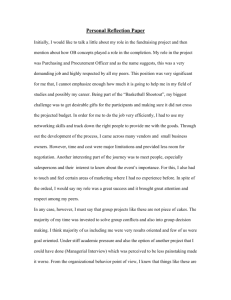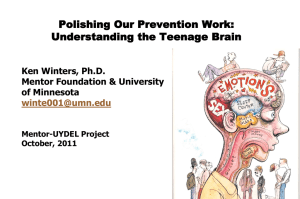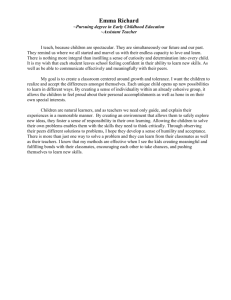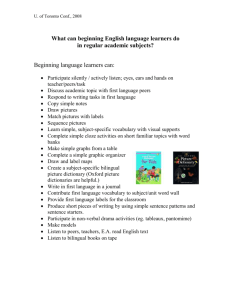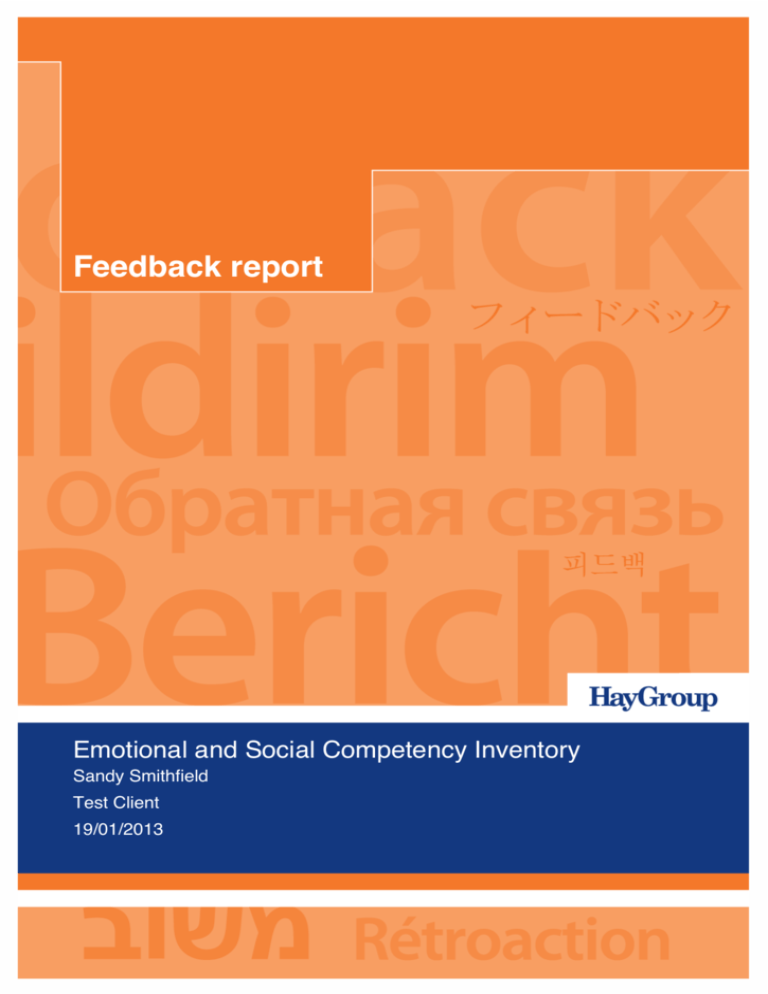
Feedback report
Emotional and Social Competency Inventory
Sandy Smithfield
Test Client
19/01/2013
Sandy Smithfield - Test Client
Introduction
What is emotional and social intelligence?
Emotional and social intelligence is the capacity for recognising our own
feelings and those of others, for motivating ourselves, and for managing
emotions effectively in ourselves and in others. It describes the behaviours
that sustain people in challenging roles, or as their careers become more
demanding, and it captures the qualities that help people deal effectively
with change.
The emotional and social competency inventory
Based on decades of research, across hundreds of roles and
organisations, the emotional and social competency inventory (ESCI)
model describes twelve competencies that differentiate outstanding from
average performers. Although all of the ESCI competencies are important,
you may not need to master all of them in order to be successful. You may
draw on different competencies, depending on your strengths,
preferences, and the needs of the people and situations you work with.
The four clusters
The ESCI clusters highlight four distinct areas of ability:
•
•
self-awareness: recognising and understanding our own emotions
•
•
self-management: effectively managing our own emotions
social awareness: recognising and understanding the emotions of
others
relationship management: applying emotional understanding in our
dealings with others.
Relationship management is where emotional and social intelligence (or
the lack thereof) becomes most visible to others. The competencies in this
cluster impact on the motivation and performance of others, but they
depend on strengths in the social awareness and self-management
competencies. These clusters provide direction, energy, restraint, and
skill to the way we use relationship management competencies.
Self-awareness is at the heart of the model. It describes the ability to
understand our emotions, our drives, our strengths and our weaknesses.
It enables us to sustain our emotionally and socially intelligent behaviour
over time, despite setbacks.
Continued
19/01/2013
© 2013 Daniel Goleman, Ph.D and Richard Boyatzis,
Ph.D. Distributed by the Hay Group. All rights
reserved.
1
Sandy Smithfield - Test Client
Introduction
Your feedback report
Your feedback report is organised into seven major sections:
19/01/2013
•
ESCI model: a list of the competencies measured in this survey,
organised by cluster.
•
Interpreting your feedback: a guide to what you'll see in your ESCI
feedback report.
•
Data validity: a summary of the source and quality of the feedback data,
and of the agreement within rater groups.
•
ESCI summary: a summary of your strengths and areas for
improvement across the four clusters of emotional competencies.
•
ESCI detail: your detailed competency scores, by rater group, with
competency definitions.
•
Item frequency report: a distribution of ratings, by rater group, for each
item in the ESCI.
•
Verbatim comments: written comments about your behaviour and
performance from those who provided you with feedback.
© 2013 Daniel Goleman, Ph.D and Richard Boyatzis,
Ph.D. Distributed by the Hay Group. All rights
reserved.
2
Sandy Smithfield - Test Client
Emotional and Social Competency Inventory
Self-awareness
•
Emotional self-awareness
Self-management
•
•
•
•
Achievement orientation
Adaptability
Emotional self-control
Positive outlook
Social awareness
•
•
Empathy
Organisational awareness
Relationship management
•
•
•
•
•
19/01/2013
© 2013 Daniel Goleman, Ph.D and Richard Boyatzis,
Ph.D. Distributed by the Hay Group. All rights
reserved.
Conflict management
Coach and mentor
Influence
Inspirational leadership
Teamwork
3
Sandy Smithfield - Test Client
Interpreting your
feedback
A guide to what you'll see in your
ESCI feedback report
Interpreting the ESCI summary
The ESCI summary provides an overview of your strengths and areas for
improvement. All the competencies measured in this report are listed and
organised by cluster.
Competency scores
To the right of each competency, you will see 'Avg. total others rating'.
This is the average score from everyone, excluding yourself, who
provided you with feedback.
Avg.
total
others
rating
Consistency of demonstration
Never
Sometimes
Rarely
Strength
Consistently
Often
3.8
4.3
Total others
Self
Norm group
The bar represents your total others score.
The circle represents your rating, or how you saw yourself on that
competency.
Norms: the transparent box represents the norm group. That is, the scores
ranging from the 25th percentile to the 75th percentile of others who have
taken the ESCI. The norm group shown represents a sample of 4,014
individuals and 42,092 respondents.
•
If your total others score (represented by the bar) is to the left of this
box, it indicates your score is below average for this competency.
•
If your total others score is to the right of the box, it indicates you are
above average on this competency.
When the total others score matches or exceeds 85% of the scale, the
competency is considered a strength. In this case, an arrow will appear
for that competency under the strength column.
Interpreting the competency detail
The ESCI competency detail report provides scores by rater group for
each of the emotional competencies measured in this report.
Continued
19/01/2013
© 2013 Daniel Goleman, Ph.D and Richard Boyatzis,
Ph.D. Distributed by the Hay Group. All rights
reserved.
4
Sandy Smithfield - Test Client
Interpreting your
feedback
Competency scales: To the right of the graph is the scale upon which the
competencies were assessed. The bar graph represents the average
competency score for each rater group.
A guide to what you'll see in your
ESCI feedback report
Consistently
Often
Sometimes
Rarely
Never
Total Others
Self
Manager
Direct Reports
Peers
Norms: the shaded area represents the norm group or average range of
scores (e.g. 25th to 75th percentile) for this competency. When a bar is
above the shaded area, your rating is considered above average for this
competency. When a bar is below the shaded area, it is considered below
average for this competency.
19/01/2013
© 2013 Daniel Goleman, Ph.D and Richard Boyatzis,
Ph.D. Distributed by the Hay Group. All rights
reserved.
5
Sandy Smithfield - Test Client
Data validity
This report is based on the responses of 10 individuals as shown below.
Summarises the source and
quality of the feedback data
10 questionnaires were returned in time to be included in this feedback.
The responses were collected between 04/05/2011 and 10/05/2011.
Questionnaires
Distb. Rcvd. Prcsd.
Self
Manager
Direct Reports
Peers
1
1
4
5
1
1
4
4
Familiarity
Low
High
Agreement
Low
High
1
1
4
4
Rater familiarity
When making their ratings, raters indicated their familiarity with your job
performance and their frequency of work-related contact with you.
The higher the familiarity, the more attention you should pay to the ratings.
Low familiarity can occur when raters report that they are relatively
unfamiliar with your job performance, or have relatively infrequent workrelated contact with you (or both). You should place less weight on
feedback from perspectives with low to moderate familiarity.
Rater agreement
The level of rater agreement for perspectives with two or more raters is
reported above. The higher the agreement, the more consistent the
ratings within the rater group's perspective.
Agreement can be low for a number of reasons. Low agreement may
indicate that some raters are less familiar with your performance than
others. Low agreement may also indicate that the raters interact with you
in different situations and see different aspects of your behaviour. If the
agreement for a perspective is low or moderate you should take time to
consider the likely cause of the inconsistency and to adjust your
evaluation of the feedback appropriately.
19/01/2013
© 2013 Daniel Goleman, Ph.D and Richard Boyatzis,
Ph.D. Distributed by the Hay Group. All rights
reserved.
6
Sandy Smithfield - Test Client
ESCI summary
Cluster / Competencies
Avg.
total
others
rating
Never
Self-awareness
Emotional self-awareness
Consistency of demonstration
Sometimes
Rarely
Strength
Consistently
Often
3.8
Self-management
Achievement orientation
3.3
Adaptability
2.7
Emotional self-control
4.1
Positive outlook
3.9
Social awareness
Empathy
4.4
Organisational awareness
3.4
Relationship management
Conflict management
3.2
Coach and mentor
4.4
Influence
3.2
Inspirational leadership
3.4
Teamwork
4.8
Total others
19/01/2013
© 2013 Daniel Goleman, Ph.D and Richard Boyatzis,
Ph.D. Distributed by the Hay Group. All rights
reserved.
Self
Norm group
7
Sandy Smithfield - Test Client
Self-awareness
Strength
Emotional self-awareness
Recognising how our emotions affect our performance. People who demonstrate this competency know the
signals that tell them what they're feeling, and use them as an ongoing guide to how they are doing.
Consistently
Often
Sometimes
Rarely
Never
Total Others
Self
Manager
Direct Reports
Peers
Continued
19/01/2013
© 2013 Daniel Goleman, Ph.D and Richard Boyatzis,
Ph.D. Distributed by the Hay Group. All rights
reserved.
8
Sandy Smithfield - Test Client
Self-management
Strength
Achievement orientation
Striving to meet or exceed a standard of excellence. People who demonstrate this competency look for ways
to do things better, set challenging goals and take calculated risks.
Consistently
Often
Sometimes
Rarely
Never
Total Others
Self
Manager
Direct Reports
Peers
Adaptability
Flexibility in handling change. People who demonstrate this competency willingly change their own ideas or
approaches based on new information or changing needs. They are able to juggle multiple demands.
Consistently
Often
Sometimes
Rarely
Never
Total Others
Self
Manager
Direct Reports
Peers
Emotional self-control
Keeping disruptive emotions and impulses in check. People who demonstrate this competency are able to
maintain their effectiveness under stressful or hostile conditions.
Consistently
Often
Sometimes
Rarely
Never
Total Others
Self
Manager
Direct Reports
Peers
Continued
19/01/2013
© 2013 Daniel Goleman, Ph.D and Richard Boyatzis,
Ph.D. Distributed by the Hay Group. All rights
reserved.
9
Sandy Smithfield - Test Client
Self-management
Strength
Positive outlook
Persistence in pursuing goals despite obstacles and setbacks. People who demonstrate this competency
see the positive in people, situations and events more often than the negative.
Consistently
Often
Sometimes
Rarely
Never
Total Others
Self
Manager
Direct Reports
Peers
Continued
19/01/2013
© 2013 Daniel Goleman, Ph.D and Richard Boyatzis,
Ph.D. Distributed by the Hay Group. All rights
reserved.
10
Sandy Smithfield - Test Client
Social awareness
Strength
Empathy
Sensing others' feelings and perspectives, and taking an active interest in their concerns. People who
demonstrate this competency are able to pick up cues, understanding what is being felt and thought.
Consistently
Often
Sometimes
Rarely
Never
Total Others
Self
Manager
Direct Reports
Peers
Organisational awareness
Reading a group's emotional currents and power relationships. People who demonstrate this competency
think about power relationships. They can accurately identify influencers, networks and dynamics.
Consistently
Often
Sometimes
Rarely
Never
Total Others
Self
Manager
Direct Reports
Peers
Continued
19/01/2013
© 2013 Daniel Goleman, Ph.D and Richard Boyatzis,
Ph.D. Distributed by the Hay Group. All rights
reserved.
11
Sandy Smithfield - Test Client
Relationship management
Strength
Conflict management
Negotiating and resolving conflict. People who demonstrate this competency bring disagreements into the
open, effectively communicate the different positions and find solutions all can endorse.
Consistently
Often
Sometimes
Rarely
Never
Total Others
Self
Manager
Direct Reports
Peers
Coach and mentor
Taking an active interest in the development needs of others and bolstering their abilities. People who
demonstrate this competency spend time helping people via feedback, support and assignments.
Consistently
Often
Sometimes
Rarely
Never
Total Others
Self
Manager
Direct Reports
Peers
Influence
Having a positive impact on others. People who demonstrate this competency persuade or convince others
to gain support for an agenda.
Consistently
Often
Sometimes
Rarely
Never
Total Others
Self
Manager
Direct Reports
Peers
Continued
19/01/2013
© 2013 Daniel Goleman, Ph.D and Richard Boyatzis,
Ph.D. Distributed by the Hay Group. All rights
reserved.
12
Sandy Smithfield - Test Client
Relationship management
Strength
Inspirational leadership
Inspiring and guiding individuals and groups. People who demonstrate this competency work to bring people
together to get the job done. They bring out the best in people.
Consistently
Often
Sometimes
Rarely
Never
Total Others
Self
Manager
Direct Reports
Peers
Teamwork
Working with others towards a shared goal. Creating group synergy in pursuing collective goals. Teamwork
is an orientation to work with others interdependently, not separately or competitively.
Consistently
Often
Sometimes
Rarely
Never
Total Others
19/01/2013
Self
Manager
Direct Reports
Peers
© 2013 Daniel Goleman, Ph.D and Richard Boyatzis,
Ph.D. Distributed by the Hay Group. All rights
reserved.
13
Sandy Smithfield - Test Client
Item frequency report
The following charts show how your raters responded to each questionnaire item. It indicates, item by item, where
raters' perceptions of your behaviour agree or differ.
The bars on the 'Average rating' column represent the average item score for each rater group. The distribution of
ratings, with a column for each point on the rating scale, are shown to the right of the bars. The number in each
column indicates the number of raters who rated you on that point. The left most column labeled with a * indicates
the number of raters who did not answer the question.
Self-awareness Cluster
Emotional self-awareness
Never
#
ITEM
Rater group
34
Able to describe how own feelings affect own actions. Self
Average rating
Describes underlying reasons for own feelings.
Manager
1
Direct Reports
63
Does not describe own feelings.
Acknowledges own strengths and weaknesses.
Manager
1
1
Self
2
1
1
1
1
1
2
1
3
1
Manager
1
Direct Reports
Peers
1
Self
1
Manager
1
Direct Reports
Peers
Self
Direct Reports
Peers
3
1
Self
Manager
*
4
1
Peers
48
1
Direct Reports
Shows awareness of own feelings.
3
Self
Manager
44
1
Peers
Aware of the connection between what is happening
and own feelings.
*
1
Direct Reports
41
Consistently
Peers
39
-
1
1
1
1
1
3
1
2
2
1
3
2
1
1
1
1
2
2
3
reversed item
Indicates that some of your assessors did not respond to this item.
Continued
19/01/2013
© 2013 Daniel Goleman, Ph.D and Richard Boyatzis,
Ph.D. Distributed by the Hay Group. All rights
reserved.
14
Sandy Smithfield - Test Client
Item frequency report
Self-management Cluster
Achievement orientation
Never
#
ITEM
Rater group
9
Initiates actions to improve own performance.
Self
Average rating
Peers
1
1
1
Manager
1
Self
2
2
1
1
1
3
1
1
1
2
1
1
1
3
3
Self
Peers
1
2
Peers
Direct Reports
1
3
Self
Manager
1
Direct Reports
*
1
1
Manager
Seeks ways to do things better.
2
Peers
57
1
Direct Reports
Does not try to improve.
1
1
2
Self
Manager
40
2
Peers
Strives to improve own performance.
2
1
Direct Reports
36
1
Peers
Does not strive to improve own performance.
1
Direct Reports
Direct Reports
29
1
Seeks to improve own self by setting measurable and Self
challenging goals.
Manager
Consistently
*
Manager
28
-
1
1
1
1
1
3
1
4
reversed item
Indicates that some of your assessors did not respond to this item.
Continued
19/01/2013
© 2013 Daniel Goleman, Ph.D and Richard Boyatzis,
Ph.D. Distributed by the Hay Group. All rights
reserved.
15
Sandy Smithfield - Test Client
Item frequency report
Self-management Cluster
Adaptability
Never
#
ITEM
Rater group
1
Has difficulty adapting to uncertain and changing
conditions.
Self
Manager
Average rating
10
Adapts by smoothly juggling multiple demands.
1
1
Self
2
2
1
1
2
1
2
3
1
1
1
3
2
1
2
1
1
Peers
Peers
1
1
Direct Reports
Direct Reports
2
Self
Adapts overall strategy, goals, or projects to cope with Self
unexpected events.
Manager
1
Self
Manager
1
Peers
*
3
Manager
Direct Reports
51
2
1
Manager
Adapts to shifting priorities and rapid change.
1
Peers
42
1
Self
Direct Reports
Adapts overall strategy, goals, or projects to fit the
situation.
1
Manager
35
1
Peers
Adapts by applying standard procedures flexibly.
1
Direct Reports
19
Consistently
*
Direct Reports
Peers
-
1
3
1
1
1
2
1
1
1
1
1
1
1
1
3
reversed item
Indicates that some of your assessors did not respond to this item.
Continued
19/01/2013
© 2013 Daniel Goleman, Ph.D and Richard Boyatzis,
Ph.D. Distributed by the Hay Group. All rights
reserved.
16
Sandy Smithfield - Test Client
Item frequency report
Self-management Cluster
Emotional self-control
Never
ITEM
Rater group
4
Gets impatient or shows frustration inappropriately.
Self
1
Manager
1
Direct Reports
16
18
58
59
Acts appropriately even in emotionally charged
situations.
Remains calm in stressful situations.
Remains composed, even in trying moments.
Controls impulses appropriately in situations.
Average rating
3
3
2
Self
1
Manager
1
Direct Reports
Peers
1
1
2
1
1
3
Self
1
Manager
1
Direct Reports
Peers
1
2
1
3
2
Self
1
Manager
1
Direct Reports
Peers
1
1
2
1
1
3
Self
1
Manager
1
Self
Peers
1
2
2
3
1
Manager
Direct Reports
1
Peers
Loses composure when under stress.
1
Direct Reports
60
Consistently
*
#
Peers
*
-
1
1
1
1
2
1
3
reversed item
Indicates that some of your assessors did not respond to this item.
Continued
19/01/2013
© 2013 Daniel Goleman, Ph.D and Richard Boyatzis,
Ph.D. Distributed by the Hay Group. All rights
reserved.
17
Sandy Smithfield - Test Client
Item frequency report
Self-management Cluster
Positive outlook
Never
Consistently
*
#
ITEM
Rater group
Average rating
2
Sees the positive in people, situations, and events
more often than the negative.
Self
1
Manager
1
Direct Reports
45
Believes the future will be better than the past.
1
Manager
1
Sees possibilities more than problems.
1
Manager
1
Direct Reports
Peers
4
3
3
1
1
3
1
1
1
Self
Direct Reports
1
Self
Manager
Sees the positive side of a difficult situation.
1
1
Peers
65
2
Direct Reports
Sees opportunities more than threats.
1
Self
Manager
62
1
Peers
55
1
Self
Peers
Views the future with hope.
3
Direct Reports
50
1
Peers
*
-
1
2
3
2
1
1
1
2
1
1
3
Self
1
Manager
1
Direct Reports
Peers
1
1
2
1
4
1
reversed item
Indicates that some of your assessors did not respond to this item.
Continued
19/01/2013
© 2013 Daniel Goleman, Ph.D and Richard Boyatzis,
Ph.D. Distributed by the Hay Group. All rights
reserved.
18
Sandy Smithfield - Test Client
Item frequency report
Social awareness Cluster
Empathy
Never
#
ITEM
Rater group
23
Understands another person's motivation.
Self
1
Self
2
Self
1
Manager
1
1
1
2
1
3
Peers
Self
1
Manager
1
Direct Reports
Self
2
1
2
3
1
Manager
1
Direct Reports
Peers
3
1
1
Peers
Understands others' perspectives when they are
different from own perspective.
3
3
Direct Reports
53
2
1
1
Peers
Understands others by putting self into their shoes.
1
Direct Reports
43
2
1
Manager
Does not understand subtle feelings of others.
1
Peers
31
1
Direct Reports
Understands others by listening attentively.
Consistently
*
Average rating
Manager
30
-
1
2
1
5
Organisational awareness
Never
Consistently
*
#
ITEM
Rater group
6
Understands social networks.
Self
1
Manager
1
Direct Reports
Peers
*
-
Average rating
1
2
1
2
3
reversed item
Indicates that some of your assessors did not respond to this item.
Continued
19/01/2013
© 2013 Daniel Goleman, Ph.D and Richard Boyatzis,
Ph.D. Distributed by the Hay Group. All rights
reserved.
19
Sandy Smithfield - Test Client
Item frequency report
Social awareness Cluster
Organisational awareness
Never
*
ITEM
Rater group
13
Understands the values and culture of the team or
organisation.
Self
1
Manager
1
Understands the informal structure in the team or
organisation
Direct Reports
Peers
Self
Direct Reports
64
Understands the informal processes by which work
gets done in the team or organisation.
Understands the team's or organisation's unspoken
rules.
1
Self
Manager
Direct Reports
2
3
2
1
2
2
1
1
3
1
2
1
1
1
Manager
1
1
Self
Peers
2
1
Peers
Direct Reports
1
1
Peers
67
1
Manager
*
Consistently
#
21
Average rating
-
1
1
1
1
1
3
1
1
reversed item
Indicates that some of your assessors did not respond to this item.
Continued
19/01/2013
© 2013 Daniel Goleman, Ph.D and Richard Boyatzis,
Ph.D. Distributed by the Hay Group. All rights
reserved.
20
Sandy Smithfield - Test Client
Item frequency report
Relationship management Cluster
Conflict management
Never
#
ITEM
Rater group
8
Tries to resolve conflict instead of allowing it to fester. Self
Direct Reports
14
Resolves conflict by de-escalating the emotions in a
situation.
Self
4
1
1
1
1
1
2
4
1
1
3
1
4
1
Manager
1
Peers
1
1
Self
Direct Reports
2
1
Peers
Resolves conflict by bringing it into the open.
1
3
Manager
46
2
Self
1
1
Peers
Direct Reports
3
Direct Reports
Tries to resolve conflict by openly talking about
disagreements with those involved.
1
Manager
26
1
Peers
Allows conflict to fester.
Manager
15
1
Self
Direct Reports
Peers
Consistently
*
Average rating
Manager
-
1
1
1
1
1
4
Coach and mentor
Never
Consistently
*
#
ITEM
Rater group
22
Provides on-going mentoring or coaching.
Self
1
Manager
1
Direct Reports
Peers
*
-
Average rating
1
2
1
2
3
reversed item
Indicates that some of your assessors did not respond to this item.
Continued
19/01/2013
© 2013 Daniel Goleman, Ph.D and Richard Boyatzis,
Ph.D. Distributed by the Hay Group. All rights
reserved.
21
Sandy Smithfield - Test Client
Item frequency report
Relationship management Cluster
Coach and mentor
Never
#
ITEM
Rater group
32
Provides feedback others find helpful for their
development.
Self
Manager
1
1
Self
54
Coaches and mentors others.
Does not spend time developing others.
Manager
Direct Reports
1
2
2
1
1
3
1
4
Self
1
Manager
1
Direct Reports
Peers
1
Self
1
Manager
1
Peers
Cares about others and their development.
2
1
Direct Reports
66
1
Peers
52
1
Peers
Personally invests time and effort in developing
others.
Consistently
*
Average rating
Direct Reports
47
-
1
2
1
4
3
3
1
2
Self
1
Manager
1
Direct Reports
Peers
1
2
1
1
4
Influence
Never
#
ITEM
3
Convinces others by getting support from key people. Self
Rater group
Manager
*
Average rating
-
*
1
1
Direct Reports
Peers
Consistently
1
1
2
1
4
reversed item
Indicates that some of your assessors did not respond to this item.
Continued
19/01/2013
© 2013 Daniel Goleman, Ph.D and Richard Boyatzis,
Ph.D. Distributed by the Hay Group. All rights
reserved.
22
Sandy Smithfield - Test Client
Item frequency report
Relationship management Cluster
Influence
Never
#
ITEM
Rater group
17
Convinces others by using multiple approaches.
Self
Peers
20
Convinces others by appealing to their self-interest.
1
1
Self
Anticipates how others will respond when trying to
convince them.
68
Convinces others by developing behind-the-scenes
support.
Convinces others through discussion.
1
1
3
Direct Reports
1
1
3
3
Self
2
1
1
Direct Reports
Peers
1
2
1
3
2
Self
1
Manager
1
Direct Reports
Peers
1
Self
Manager
1
1
Manager
49
2
Peers
38
1
Manager
Consistently
*
Average rating
Manager
Direct Reports
-
1
2
1
4
1
1
Direct Reports
Peers
1
2
1
3
2
-
Consistently
Inspirational leadership
Never
ITEM
Rater group
5
Leads by building pride in the group.
Self
1
Manager
1
Direct Reports
Peers
*
Average rating
*
#
1
3
2
3
reversed item
Indicates that some of your assessors did not respond to this item.
Continued
19/01/2013
© 2013 Daniel Goleman, Ph.D and Richard Boyatzis,
Ph.D. Distributed by the Hay Group. All rights
reserved.
23
Sandy Smithfield - Test Client
Item frequency report
Relationship management Cluster
Inspirational leadership
Never
#
ITEM
Rater group
7
Leads by inspiring people.
Self
1
Does not inspire followers.
1
3
Self
1
Manager
1
Self
Leads by articulating a compelling vision.
1
2
3
2
2
1
Manager
Direct Reports
Peers
61
1
Peers
Leads by bringing out the best in people.
3
Direct Reports
27
1
Direct Reports
24
1
1
3
2
Self
1
Manager
1
Direct Reports
Peers
Consistently
*
Average rating
Manager
Peers
-
1
1
2
3
2
3
Teamwork
Never
#
ITEM
Rater group
11
Does not cooperate with others.
Self
12
*
Works well in teams by being supportive.
Consistently
*
Average rating
1
Manager
Direct Reports
Peers
-
1
1
3
4
1
Self
1
Manager
1
Direct Reports
Peers
1
3
5
reversed item
Indicates that some of your assessors did not respond to this item.
Continued
19/01/2013
© 2013 Daniel Goleman, Ph.D and Richard Boyatzis,
Ph.D. Distributed by the Hay Group. All rights
reserved.
24
Sandy Smithfield - Test Client
Item frequency report
Relationship management Cluster
Teamwork
Never
Consistently
*
#
ITEM
Rater group
25
Works well in teams by encouraging co-operation.
Self
1
Manager
1
Direct Reports
Peers
5
Self
1
33
Works well in teams by soliciting others' input.
Manager
Direct Reports
Peers
37
56
Works well in teams by being respectful of others.
Works well in teams by encouraging participation of
everyone present.
Average rating
1
3
1
1
2
1
1
4
Self
1
Manager
1
Direct Reports
Peers
1
1
2
1
4
Self
1
Manager
1
Direct Reports
Peers
*
-
1
3
1
4
reversed item
Indicates that some of your assessors did not respond to this item.
19/01/2013
© 2013 Daniel Goleman, Ph.D and Richard Boyatzis,
Ph.D. Distributed by the Hay Group. All rights
reserved.
25
Sandy Smithfield - Test Client
Verbatim
comments
Please list this person's key strengths.
Self
I take the time to understand and address employee concerns.I also look
for opportunities to celebrate events and accomplishments. I am sincerely
interested in the development of my people. I am always willing to help
them in any way I can. Morale is really good in my department,and
turnover very low.
Manager
Sandy is a real people person. She has created a pleasant work
environment and gets on well with her team. She treats reports and peers
with respect, and always keeps her self control - even in difficult situations.
Her reports feel comfortable approaching her with problems, and team
issues are dealt with quickly. She is good at developing her team, and
guiding them through any issues they have. She works well in difficult
situations, and is very quick to spot potential issues with her team. She is
effective at day to day management, and manages well with a large
number of reports.
Direct Reports
great mentor & coach a very understanding/compassionate leader
Peers
Sandy is a very caring and understanding manager with a great capacity
to get on with people. Sandy goes to great lengths to keep everyone in
the team happy and will often put others first.
Sandy has transformed HR's recruitment activities. 10 years ago the
department had no regard for the needs of line manager - it just ran it's
processes as prescribed and any specific needs were viewed as an
inconvenience. Sandy has worked hard to create a climate in which her
staff automatically think of line managers as their customers. They ask us
what we need, they listen to our ideas, they're prepared to try something
different. Sandy has created a sense of stability within her team, and a
positive team spirit that we all benefit from.
Please list specific areas where this person needs to
improve, and what would be the payoffs if this person
made these improvements?
Self
I sometimes get caught up in the people side of things, and miss out on
opportunities to articulate/communicate/enforce standards. I need to be
better about that.
Manager
Sandy needs to focus more time on delivery. She allows personal
relationships to get in the way of productivity. One or two of her team seem
to take advantage of her good relationship with them, and do not deliver
as they should. She needs to work on dealing with poor performance. Also
Sandy doesn't always 'think outside the box'. She needs to review
processes and see if there is a more efficient way to do things. She needs
Continued
19/01/2013
© 2013 Daniel Goleman, Ph.D and Richard Boyatzis,
Ph.D. Distributed by the Hay Group. All rights
reserved.
26
Sandy Smithfield - Test Client
Verbatim
comments
to focus more on the organization needs. Sandy would also benefit from
developing her relationships across the business with key people, not just
her team relationships. Her profile is not high enough across the
company.
Direct Reports
would be nice to be provided with more clarity and structure
Peers
Sandy sometimes lets team members get away with things such as
lateness and poor performance for fear of confronting them and losing
popularity. This is frustrating for the rest of the team and in the end does
not benefit anyone. If Sandy were to get tough, I think people would be
more respectful and in turn more productive.
Because Sandy has proved herself so well over the years, she's surely
ready to and capable of raising the bar. The business has reached that
point where we need something more from her and her team. What's
changed is the growth rate of our business - we need more good people,
faster. And we can't afford to hire people who aren't right for us. So what
we need from Sandy is for her to step up from being 'in' the business and
start working 'on' the business. We need her to take a helicopter view of
her department and its operations: to find out about - and try - new
approaches, the set higher standards for her team. Sandy's worked so
hard to build a good team. It's time now for her to trust - and expect - them
to deliver more.
19/01/2013
© 2013 Daniel Goleman, Ph.D and Richard Boyatzis,
Ph.D. Distributed by the Hay Group. All rights
reserved.
27



